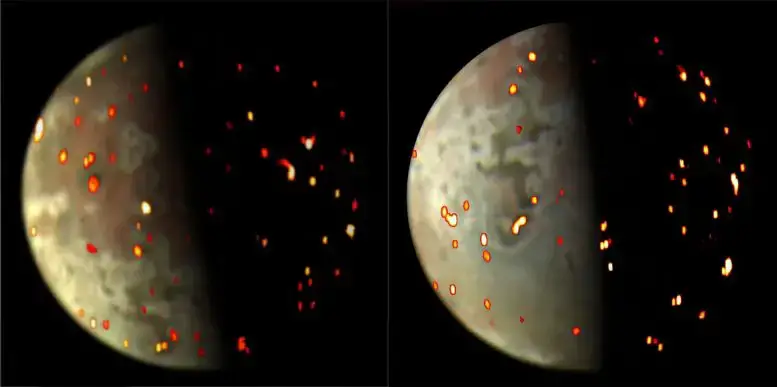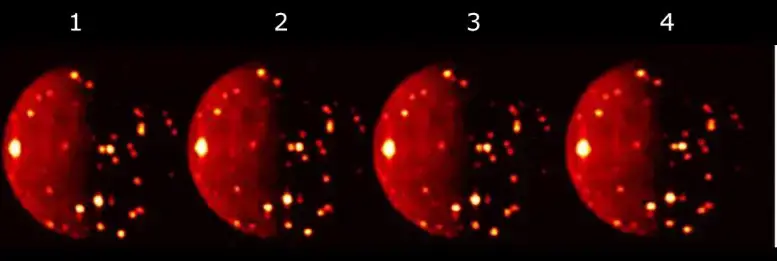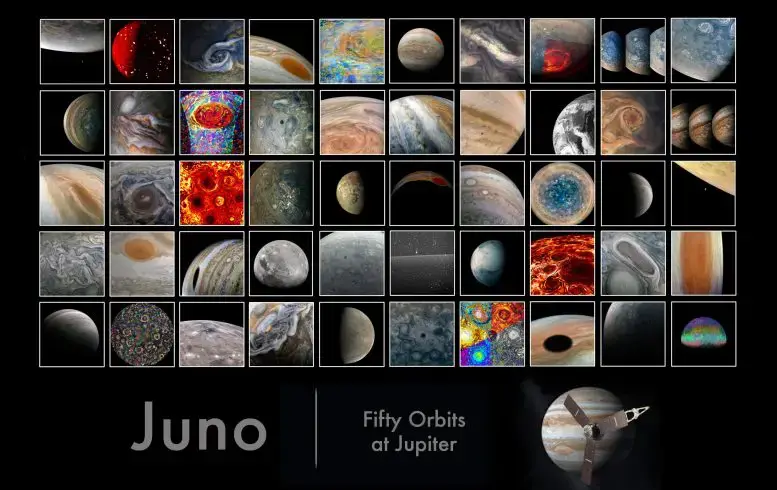The gas giant orbiter has flown over 510 million miles and also documented close encounters with three of Jupiter’s four largest moons.
NASA’s Juno spacecraft flew past Jupiter’s volcanic moon Io on May 16, and then the gas giant itself soon after. The flyby of the Jovian moon was the closest to date, at an altitude of about 22,060 miles (35,500 kilometers). Now in the third year of its extended mission to investigate the interior of Jupiter, the solar-powered spacecraft will also explore the ring system where some of the gas giant’s inner moons reside.
To date, Juno has performed 50 flybys of Jupiter and also collected data during close encounters with three of the four Galilean moons – the icy worlds Europa and Ganymede, and fiery Io.

This composite image of Io was generated using data collected by the JunoCam imager aboard NASA’s Juno spacecraft during four flybys of the Jovian moon. The resolution of the images gets progressively better as the distance between spacecraft and moon decreases with each flyby (perijove, or PJ). Credit: Image data: NASA/JPL-Caltech/SwRI/MSSS/. Image processing, left to right: Björn Jónsson (CC NC SA), Jason Perry (CC NC SA), Mike Ravine (CC BY), Kevin M. Gill (CC BY)
“Io is the most volcanic celestial body that we know of in our solar system,” said Scott Bolton, Juno principal investigator from the Southwest Research Institute in San Antonio. “By observing it over time on multiple passes, we can watch how the volcanoes vary – how often they erupt, how bright and hot they are, whether they are linked to a group or solo, and if the shape of the lava flow changes.”
Slightly larger than Earth’s moon, Io is a world in constant torment. Not only is the biggest planet in the solar system forever pulling at it gravitationally, but so are its Galilean siblings – Europa and the biggest moon in the solar system, Ganymede. The result is that Io is continuously stretched and squeezed, actions linked to the creation of the lava seen erupting from its many volcanoes.

These composite views depicting volcanic activity on Io were generated using both visible light and infrared data collected by NASA’s Juno spacecraft during flybys of the Jovian moon on December 14, 2022 (left) and March 1, 2023.Credit: NASA/JPL-Caltech/SwRI/ASI/INAF/JIRAM
While Juno was designed to study Jupiter, its many sensors have additionally provided a wealth of data on the planet’s moons. Along with its visible light imager JunoCam, the spacecraft’s JIRAM (Jovian InfraRed Auroral Mapper), SRU (Stellar Reference Unit), and MWR (Microwave Radiometer) will be studying Io’s volcanoes and how volcanic eruptions interact with Jupiter’s powerful magnetosphere and auroras.
“We are entering into another amazing part of Juno’s mission as we get closer and closer to Io with successive orbits. This 51st orbit will provide our closest look yet at this tortured moon,” said Bolton. “Our upcoming flybys in July and October will bring us even closer, leading up to our twin flyby encounters with Io in December of this year and February of next year, when we fly within 1,500 kilometers of its surface. All of these flybys are providing spectacular views of the volcanic activity of this amazing moon. The data should be amazing.”

These infrared views of volcanic activity of Jupiter’s moon Io were collected by the JIRAM (Jovian Infrared Auroral Mapper) instrument aboard NASA’s Juno spacecraft during a flyby of the moon on October 16, 2021. Credit: NASA/JPL-Caltech/SwRI/ASI/INAF/JIRAM
A “Half-Century” at Jupiter
During its flybys of Jupiter, Juno has zoomed low over the planet’s cloud tops – as close as about 2,100 miles (3,400 kilometers). Approaching the planet from over the north pole and exiting over the south during these flybys, the spacecraft uses its instruments to probe beneath the obscuring cloud cover, studying Jupiter’s interior and auroras to learn more about the planet’s origins, structure, atmosphere, and magnetosphere.

This downloadable graphic contains 50 image highlights from NASA’s Juno mission to Jupiter. Juno completed its 50th close pass of the gas giant on April 8, 2023.
Juno has been orbiting Jupiter for more than 2,505 Earth days and flown over 510 million miles (820 million kilometers). The spacecraft arrived at Jupiter on July 4, 2016. The first science flyby occurred 53 days later, and the spacecraft continued with that orbital period until its flyby of Ganymede on June 7, 2021, which reduced its orbital period to 43 days. The Europa flyby on September 29, 2022, reduced the orbital period to 38 days. After the next two Io flybys, on May 16 and July 31, Juno’s orbital period will remain fixed at 32 days.
“Io is only one of the celestial bodies which continue to come under Juno’s microscope during this extended mission,” said Juno’s acting project manager, Matthew Johnson of NASA’s Jet Propulsion Laboratory in Southern California. “As well as continuously changing our orbit to allow new perspectives of Jupiter and flying low over the nightside of the planet, the spacecraft will also be threading the needle between some of Jupiter’s rings to learn more about their origin and composition.”
More About the Mission
NASA’s Jet Propulsion Laboratory (JPL), a division of Caltech in Pasadena, California, manages the Juno mission for the principal investigator, Scott J. Bolton, of the Southwest Research Institute in San Antonio. Juno is part of NASA’s New Frontiers Program, which is managed at NASA’s Marshall Space Flight Center in Huntsville, Alabama, for the agency’s Science Mission Directorate in Washington. Lockheed Martin Space in Denver built and operates the spacecraft.





